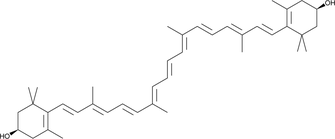Description
A carotenoid with diverse biological activities; decreases immobility time in the forced swim test and reduces hippocampal levels of IL-6, IL-1β, and TNF-α in a rat model of STZ-induced diabetes at 50 mg/kg; reduces albuminuria, serum levels of urea nitrogen and MDA, and kidney damage in a rat model of STZ-induced diabetic nephropathy; high dietary intake of zeaxanthin is positively correlated with reduced risk of advanced neovascular age-related macular degeneration in humans
Formal name: β,β-carotene-3R,3’R-diol
Synonyms: Anchovyxanthin|Xanthophyll 3|Zeaxanthol
Molecular weight: 568.9
CAS: 144-68-3
Purity: ≥98%
Formulation: A crystalline solid
Product Type|Biochemicals|Natural Products|Carotenoids||Product Type|Biochemicals|Ox Stress Reagents|Antioxidants||Research Area|Cardiovascular System|Kidney & Renal Disease|Diabetic Nephropathy||Research Area|Endocrinology & Metabolism|Metabolic Diseases|Diabetes||Research Area|Neuroscience|Behavioral Neuroscience|Depression||Research Area|Neuroscience|Ophthalmology||Research Area|Oxidative Stress & Reactive Species|Antioxidant Activity||Research Area|Oxidative Stress & Reactive Species|Lipid Peroxidation




